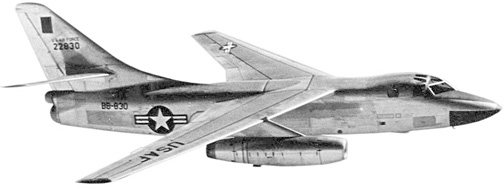
Douglas EB-66

By Randy Q Jones
|
I was an ECM officer in the 42nd TEWs, 388 TFW at Korat RTAFB, Thailand, from July 1972 to Aug 1973. After rotating back to the States, I went TDY to Castle AFB for B-52 upgrade training in -52F models.
About Nov 1973 I ran into a buddy from the 42nd at Castle who had just entered a later B-52 upgrade class. He told me that they flew all the EB-66s at Korat except two to Kadena for disposal. The two that remained were unflyable—one was at the end of the runway where it had crashed [54-540], and another had jumped its chocks on power run-up on the trim ramp, rolled into a light pole, and ruined the wing's leading edge [54-445]. Those planes were disposed of at Korat by burning as a fire crew exercise.
The last years of life of the EB-66 were plagued with maintenance problems, primarily fuel cell leaks and engine failures. The Air Force transferred nearly every -66C and -66E in the inventory to Korat to support the mission (some were flown from Germany). When they scrapped the planes at Kadena, it completely wiped out the species—I know of no true examples of those planes anywhere.

The RB-66B at Wright-Patterson sitting next to the F-105G Wild Weasel is painted like our EB-66E, but is incorrect. It doesn't have the correct jamming antennas on the belly and there is no IR jammer on the tail. I wasn't able to see inside the plane, but I suppose the ECM panel is completely different. There appears to be no C models anywhere, which is sad, because it was by far the more interesting ECM mission.
The Allison J-71 was a real problem. It had a high failure rate since it was really old and hadn't been in production for years. When they flew [54-419] to Davis-Monthan (because it exceeded allowable airframe hours), the joke around the squadron was that it came back as pieces—but the engines were the valuable commodity. At one time we had about 20 airframes at Korat, but only five or six sets of usable engines. Maintenance crews would rotate the engines around the airframes to try to balance the hours on the airframes. This caused a problem for us aircrews, since it usually took three or four flights to get the bugs out of the plane and then it was grounded shortly thereafter with an engine swap.

Interestingly, the J-71 was not originally designed for use on an airplane such as the EB-66, and rather as a powerplant for an air-breathing missle. The upshot of this was that there was no drain in the compressor stage to drain out excess fuel when the engine was shut down. It was the crew chief's job (or mine, if we landed at other than our home base) to crawl under each engine and open the manual drain valve before the pilot shut down the engines. You can bet I stayed away from the intake, avoided the bleed-air vents, and wore ear protection! It also had the effect of "cheesing off" the base commanders of non-Korat bases when we drained JP-4 all over their ramp and created a fire hazard.
EB-66 also had the distinction of being one of two aircraft types in the inventory that used probe-and-drogue air refueling—F-105G was also capable, but had been converted to the standard receptacle behind the cockpit, and they never used the probe. We had to have a special KC-135 "papa" tanker launched for us, and it had a drogue hose and basket on the refueling boom that had to be attached on the ground. The pilots hated the refueling job. The plane had a tendency to nose-up when power was applied and nose-down when pulled off, so they had to compensate for nose position when trying to maintain distance. The tanker "boomer" just sat and watched the pilot sweat it out.
In spite of the difficulties, the mission was outstanding. It was a real ECM operator's plane. I was able to maintain skills in both reconaissance (C model) and jamming (E model). Each job was different, requiring different skills, and it was by far the best job I had in the Air Force.
Additional material from Edward T. Rock (Col, USAF ret), 8/18/03 — Some comments on the EB-66 are in error, in at least the portion referring to the F-105G and the air-refueling probe. All F-105s had both a boom and probe, and drogue capability. I had two tours as an F-105F/G Wild Weasel pilot and was commander of the 17th WWS apparently at the same time the author was at Korat, also had one combat mission in the EB-66. We often used both boom and probe capability, especially when we were assigned the same tanker as the EB-66. In addition, the boom receptacle on all F-105s was forward of the cockpit, not behind the cockpit. In the F-4 the receptacle was behind the cockpit.
|



